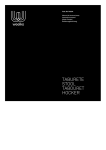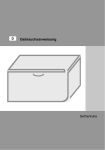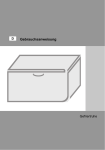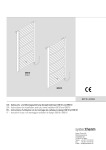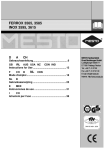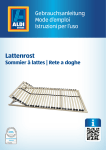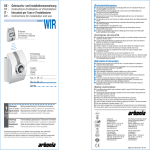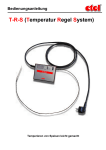Download Beschreibung SR 121/..
Transcript
Beschreibung SR 121/.. Tl.Nr.: 99102 110607 1. Anwendung, Funktion, Bedienung Der Thermostat schaltet eine oder mehrere Lasten (z.B. Ventilatoren oder Heizungen) bis zu einem Gesamtstrom von 16A (4A bei Motorlast) ein und aus. Dies ist besonders wichtig bei der Stallüftung, in Maschinen- und Traforäumen und in Gewächshäusern, wenn die gewünschten Sollwerte unter- oder überschritten werden. Das Gerät ist beständig gegen ammoniakhaltige Dämpfe und gegen Seeluft. Der Sollwert (Skalenwert) wird am Drehknopf eingestellt. 2. Plazierung, Wartung Der Fühler muß sämtliche Temperatureinflüsse im Raum erfassen können. Er soll daher der Raumluftzirkulation ausgesetzt sein und nicht in „toten“ Ecken oder in unmittelbarer Nähe von Heiz- und Kühlflächen oder Fenstern montiert sein. Der Temperaturfühler und das Gehäuse sollten regelmäßig von Schmutz befreit werden. 3. Montage Nach Abnahme des Einstellknopfes und des Gehäuseoberteils wird das Gerät an der Wand befestigt. Es ist nur für den Anschluß an festverlegten Leitungen bestimmt. 4. Elektrischer Anschluß ACHTUNG: Fehler beim Anschluß können zur Beschädigung des Regelgerätes führen! Für Schäden, die durch falschen Anschluß und/oder unsachgemäße Handhabung entstehen, wird nicht gehaftet! − Vor Arbeiten am Gerät Leitungen spannungsfrei schalten. − Der Anschluß darf nur durch autorisiertes Fachpersonal erfolgen! − Der Anschluß ist nach dem beigefügten Prinzipschaltbild durchzuführen. − Zu beachten ist die VDE 0100, insbesondere Teil 705, sowie die EN 60730, Teil 1. − Zu beachten sind auch die Vorschriften der örtlichen EVU. − Der Temperatursensor ist so zu montieren, daß er die durchschnittliche Raumtemperatur erfassen kann (Nähe von Zu- oder Abluftkanälen meiden). − Sollte das Gerät nicht funktionieren, überprüfen Sie bitte zuerst den korrekten Anschluß und die Spannungsversorgung. 5. Technische Daten Typ Temperaturbereich Max. zul. Umgebungstemperatur Schaltdifferenz Schaltgenauigkeit Solltemperatureinstellung SR 121/1: SR 121/2, SR 121/3: Kontakte Max. zul. Schaltstrom Kl. 1-3: Kl. 1-2: Gehäuse: Maße Befestigung Schutzklasse Schutzart Gewicht SR 121/.. 0...+ 40°C -20...+ 50°C ca. ±0,75K ± 2K bei 40°C ± 4K bei 0°C Drehknopf Drehknopf auf Innenskala Umschaltkontakt 16(4)A 250V AC; 10(4)A 400V AC 8(4)A 250V AC; 4(2)A 400V AC ca. 112 x 145 x 68 mm (b x h x t) Wandmontage I nach DIN EN 60730-1 IP 54 ca. 310 g Description SR 121/.. 1. Application, Function, Operation The thermostat switches on or off one or several loads (for example, ventilators or heating systems) up to a total current rotary of 16A (4A in the case of a motor load). This is particularly important in the case of stall ventilation systems, the machine and transformer rooms and in green houses when the required desired values are exceeded and not reached. The instrument is resistant to vapour containing ammoniac and salt air. The desired value (scale value) is set by means of the rotary knob. 2. Positioning, Maintenance The sensor must be able to register all the factors influencing temperature in a room. As a consequence it must be subject to the air circulating in the room and not be installed in "dead corners" or directly close to heating and cooling equipment or windows. The temperature sensor and housing is to be cleaned and the dirt removed regularly. 3. Instalation The housing of the instrument is to be fastened to the wall after removing the setting knob and the top section. The thermostat has only been designed and built for connection to permanently laid lines. 4. Electrical Connection CAUTION: Mistakes made when connecting can lead to the controller be damaged! We accept no liability for damage caused by faulty connection and/or improper treatment! − − − − Before working on the instrument disconnect the power supply cable from the voltage supply. The connection must only be made by authorised specialist personnel! The connection is to be made in accordance with the supplied principle circuit diagram. To be observed are the regulations laid down in the Federal German VDE 0100, more especially Part 705, as well as the standards EN 60730, Part 1. − To be also observed are the regulations of the local electricity board. − The temperature sensor is to be mounted in such a way that it can register the average room temperature (avoid installation close to air intake and air exhaust ducts). − Should the instrument not function please first check that the connection has been made correctly and that cable is under voltage. 5. Technical Data Type Temperature range Maximum permissible ambient temperature Hysteresis Switching accuracy Desired temperature settingSR 121/1: SR 121/2, SR 121/3: Contacts Maximum permissible switching current terminal 1-3: terminal 1-2: Housing: measurements fastening protection class type of enclosure weight Seite 2 SR 121/.. 0...+ 40°C -20...+ 50°C approx. ±0.75K ± 2K at 40°C ± 4K at 0°C rotary knob rotary knob on inside scale switch over contact 16(4)A 250V AC; 10(4)A 400V AC 8(4)A 250V AC; 4(2)A 400V AC approx. 112 x 145 x 68 mm (b x h x d) wall fitting I in accordance with DIN EN 60730-1 IP 54 approx. 310 g Description SR 121/.. 1. Utilisation, fonction, mode d’emploi Le thermostat commute une ou plusieurs charges (par exemple: ventilateurs ou courant chauffages) jusqu’à 16A (4A pour un charge moteur). Cet appareil est particulièrement recommandé pour la ventilation d’étables, de serres, ou d’espaces où se trouvent des machines, voire des transformateurs, et ce d’autant plus lorsque la valeur prescrite souhaitée est dépassée. L’appareil résiste aux vapeurs d’ammoniaque et à l’air marin. La valeur prescrite (échelle de valeur) est sélectionné au bouton de sélection. 2. Emplacement et Maintenance Le capteur doit être en mesure de saisir tous les changements de témperature de la pièce. C’est pourquoi il doit être placé à un endroit où l’air circule librement et non sur un angle mort ou à proximité de surfaces chauffante ou réfrigérante ou bien près d’une fenêtre. Le capteur de témerature ainsi que le boîtier doivent être nettoyés de temps à autre. 3. Montage Enlever le bouton de réglage et la partie supérieure du boîtier et monter l’appareil sur un mur. Le thermostat est destiné seulement pour montage aux conduits que sont posé fixe. 4. Raccordement électrique ATTENTION: Les erreurs commises lors du raccordement peuvent amener à une déterioration de l’appareil. Aucune garantie ne sera accordée pour toute déterioration due à un mauvais branchement ou à une manipulation non conforme. − Avant toute intervention sur l’appareil, couper le courant. − Le raccordement ne peut se faire que par un professionnel. − Le raccordement se fait selon le schéma de principe joint. − Respecter les normes en vigueur. − Il faut respecter le norm EN 60730, part 1. − Le détecteur de température doit être monté de sorte qu’il puisse saisir la température ambiante (éviter de le monter à proximité de bouches d’aération). − Si l’apparteil devait ne pas fontionner, procéder à la bonne vérification du branchement et de l’alimentation en courant. 5. Caractéristiques techniques Type SR 121/.. Zone de température 0...+40°C Température ambiante admissible -20...+50°C Différentiel environ ± 0,75K Degré de précision ± 2K chéz 40°C ± 4K chéz 0°C Différentes formes de commutation SR 121/1: bouton sélecteur SR 121/2, SR121/3: bouton sélecteur sur échelle interne Contacts Contact de mise en circuit Pouvoir de coupure maxi.: Kl. 1-3: 16(4)A 250V AC; 10(4)A 400V AC Kl. 1-2: 8(4)A 250V AC; 4(2)A 400V AC Boîtiers: Dimensions environ 112 x 145 x 68 mm (b x h x t) Fixation montage mural Catégorie de protection I DIN EN 60730-1 Protection IP 54 Poids environ 310 g Seite 3 6. Anschlußbild Connection Diagram Schéma de branchement 7. Maße Dimensions Dimensions Änderungen vorbehalten Seite 4 Subject to modification Sous réserve de modification





